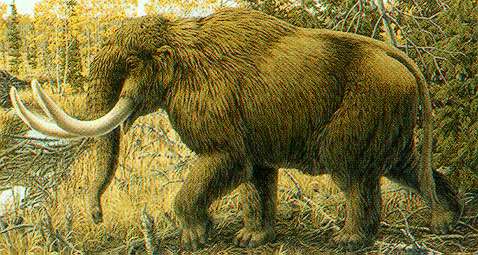|

From the 17 Jun 1897 Simcoe Reformer: "A remarkable find, that
will no doubt prove very interesting to geologists of Canada was made
last Friday morning, June 11th, by Charles Challand of Concession 5, Lot 15,
in Woodhouse township.
"It was while digging for a
drain in a marshy spot on the north end of his farm that one of the
workmen happened to strike his spade on what he first supposed to a log
of hardwood. One closer inspection, however, it proved to be formed of
bone. Concluding that something interesting and perhaps even valuable,
had been discovered, the earth was quickly removed until a tusk
measuring nine feet foot and one-half inches from tip to base was
excavated. Beneath this one, another tusk was found which although not
so long, had a greater circumstance, being nearly two feet around at the
base.
"Encouraged by these
remarkable discoveries, the search went on for more petrified remains
and as a result, a portion of the skull was brought to light, being the
upper part. This was more than three and one-half feet broad, but it
immediately crumbled, with the one portion remaining being the outer end
of the jaw and the upper part of the skull with the eye socket. The jaw
contains two whole teeth and a broken portion. The teeth are each seven
inches long and four broad. The socket for the eye measures ten inches
in breadth and eight in depth. This was attached at the base to a portion
of the backbone twenty-two inches around."
Another account, from the 17 Jun
1897 Waterford Star: "A big find was made on the farm of Mr.
Chas. Challen, lot 15, in the 5th concession, Woodhouse, last week. It
was the bones of some large animal. The tusk or horn was eight and
one-half feet long and at the one end was large as a stovepipe. The
skull was about the size of a bushel basket, with a jaw-bone in
proportion. The teeth wer seven inches long. It was reported that Mr.
Challen was offered $100 for the bones. Since writing the above we learn
that the ribs of the animal have been found and are aboue six feet long.
The other horn was found with about two feet broken off. All the bones
nearly filled a wagon box. Hundreds of people have gone to see them from
Brantford, Dover, Jarvis and other place."
In Historical Highlights of
Norfolk County, Bruce M. Pearce reproduces Mrs. Leo Challand's 1941
account of this find, which tells what happened next...
"Word was sent to Ottawa
and Dr. Ami came to search the spot. The skull, with teeth, some ribs
and toes were found. They were discovered on a bed of lakesand, under
one and one-half feet of shell marl and one and one-half feet of peat
vegetation. Dr. Ami said that this mastodon would have been five times
the size of an ordinary elephant and would have lived here from 8,000 to
40,000 years ago.
"This unusual discovery
created a sensation in the community and crowds of adults and children
visited the spot. Verbal verification of the find was make seventy years
later by two prominent and aging Norfolk citizens. Harry Austin of
Woodhouse and Harry Misner of Port Dover, who were on hand when the
mastodon remains were unearthed. They remembered that Charles Challand,
owner of the farm, had exhibited the relic in a tent at Port Dover in
Powell Park at the time of the Port Dover fall fair."
Officials from the National
Museum purchased the remains from Mr. Challand, and added it to their
exhibit of prehistoric remains in Ottawa. The National subsequently
loaned these remains to the Eva Brook Donly Museum in 1967 to display in
our then-new Centennial Wing.
A few other small Mastodon bones
and teeth were subsequently discovered in Norfolk's Windham township.
These are now on display at the Eva Brook Donly Museum.
|

